It’s not your imagination.
Retailers, restaurants, shopping centers, warehouses, apartments — especially apartments, it seems — and even some office buildings are coming out of the ground in Northeast Florida.
In 2016, groundwork was laid for much of what you will see opened and operating by the end of this year.
Editor’s Note: Abbreviated version of story provided below
Vacancy rate: 5.3 percent
Average rent: $12.61 per square foot
Retail market: Connecting with customers
Northeast Florida’s retail landscape will change dramatically with Ikea, Town Center Promenade, The Strand and The Crossing at Town Center and Durbin Pavilion, among the many other new and expanding shopping centers, stores and markets.
Also think of individual momentum by Wawa, Daily’s, Gate Petroleum Co., Aldi, Earth Fare, Ollie’s, Publix Super Markets and the dozens of other restaurants and retailers, including car washes, popping up across the landscape.
Many of those retailers and developments will open this year or are under construction.
In the meantime, the area’s shopping centers and general retail buildings ended 2016 at a vacancy rate of 5.3 percent, according to NAI Hallmark Partners.
In its fourth-quarter Jacksonville Retail Market Overview, the company said conditions improved slightly as vacancies in various forms of shopping centers dropped from 5.5 percent in the third quarter.
Overall average rental rates ended the year at $12.61 per square foot, unchanged from the prior quarter, although they are down slightly from the year before.
NAI Hallmark Partners found the highest overall retail vacancy rate was 9.9 percent on the Northbank and the lowest rates were in St. Johns and Baker counties and in Southside and at the Beaches, all between 3 and 4 percent.
Carrie Smith, managing director of the Franklin Street real estate company, said the biggest impact her group sees in the market will be the amount of retail space that will hit Jacksonville in 2017.
In addition, Smith said boutique retailing from independent clothing shops to specialized fitness retailers is thriving and she expects to see more personalized neighborhood shopping and service businesses.
Connections with customers are changing how retailing works. “It’s undeniable now, that as a retailer you have to have a model that connects customers from a variety of different channels, that luckily for us in commercial real estate, does include having a storefront,” Smith said.
Smith, talking about the tenant side of the deals, said national chains and local mom-and-pop clothing stores are connecting through various media channels to bring customers into the stores.
Not only that, large internet companies like Amazon now are looking for storefronts.
Whitney Butler Kantor, Franklin Street’s director of retail leasing, represents landlords and shopping center owners.
She predicts several trends, including the reuse of historic buildings and community and business movements to spark more shopping and restaurants in neighborhoods.
Also, the lack of retail construction the past few years created a shortage of space in some markets, leading retailers to use non-traditional locations, such as former vacant or abandoned buildings or smaller centers. The trend will continue, she said.
Across the country, some landlords with large vacant buildings are turning to another option — food halls and markets, which bring in chefs, produce sellers and artisanal food.
Those concepts “are finding their way into cities with strong foodie cultures like Jacksonville,” Kantor said.
To view full article, please visit https://www.jaxdailyrecord.com/article/economic-indicators-commercial-real-estate-favorable-2017



